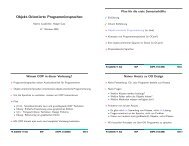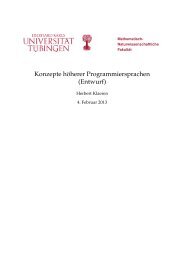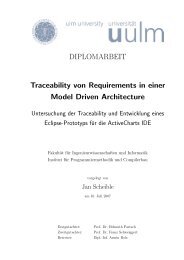Automated Model Quality Rating of Embedded Systems
Automated Model Quality Rating of Embedded Systems
Automated Model Quality Rating of Embedded Systems
You also want an ePaper? Increase the reach of your titles
YUMPU automatically turns print PDFs into web optimized ePapers that Google loves.
circle. A polygon is formed by connecting the measured values. Its red (or dark) areas<br />
highlight outliers more clearly.<br />
3.2 Aggregation <strong>of</strong> evaluations<br />
Section 3.1 described the evaluation <strong>of</strong> metrics. After evaluation, all leaves in the quality<br />
model have an assigned evaluation <strong>of</strong> between 0% and 100%. The next step is to<br />
aggregate the evaluations in the quality model. In other words a procedure is required<br />
that describes how the metric evaluations can first be aggregated into criteria and, in the<br />
next step, into factors. Aggregated results provide a quick overview <strong>of</strong> a model’s quality.<br />
During aggregation, a criterion with four metrics, for example, three <strong>of</strong> which are<br />
fulfilled with 100% and one with 0%, should not be evaluated as being 75% fulfilled. If<br />
one or more metrics are not fulfilled at all or only fulfilled to a minimal extent, this should<br />
lead to a devaluation instead. Thus the evaluation <strong>of</strong> the criterion must be worse than<br />
average. This can be achieved by multiplying the arithmetic mean with the evaluation<br />
percentages that are larger than a designated threshold value. This results in the following<br />
equation for calculating an aggregated evaluation:<br />
∑<br />
evaluation i (<br />
i<br />
#evaluationsOverT hreshold<br />
aggregatedEvaluation =<br />
·<br />
}<br />
#evaluations<br />
{{ }<br />
#evaluations<br />
Arithmetic mean<br />
) exponent<br />
} {{ }<br />
Damping factor<br />
(1)<br />
The damping factor can be further reduced using an exponent, so that evaluations<br />
under the chosen threshold value lead to a greatly reduced aggregated evaluation. If all<br />
evaluations lie above the threshold value, the aggregated evaluation corresponds with the<br />
arithmetic mean. The threshold value can be selected globally or for each aggregation<br />
step individually. It can be chosen, for example, in accordance with the ASIL (automotive<br />
safety integrity level) defined in ISO 26262. The ASIL determines how many <strong>of</strong> the<br />
specified ISO measures must be fulfilled. If the evaluations that are being aggregated<br />
are also weighted, then a weighted arithmetic mean must be used in place <strong>of</strong> a simple<br />
arithmetic mean.<br />
60<br />
Exponent = 1<br />
Exponent = 2<br />
Exponent = 3<br />
60<br />
Exponent = 1<br />
Exponent = 2<br />
Exponent = 3<br />
Aggregated evaluation (in percent)<br />
50<br />
40<br />
30<br />
20<br />
Aggregated evaluation (in percent)<br />
50<br />
40<br />
30<br />
20<br />
10<br />
10<br />
0<br />
0 20 40 60 80 100<br />
Threshold value (in percent)<br />
0<br />
0 20 40 60 80 100<br />
Threshold value (in percent)<br />
Fig. 3. Aggregation <strong>of</strong> e 1 = [25%, 30%, 35%] and e 2 = [10%, 80%, 90%]








